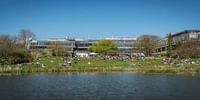Research carried out by our staff is helping to define the emerging science of the EarthÕs surface and focuses on three overarching questions:
What processes drive the dynamics and co-evolution of rivers and their ecosystems?ÊÊ
Our research has demonstrated the two-way nature of the feedbacks between the physical and biological processes of fluvial systems and has shown how these interactions help to explain the complex three-dimensional form and dynamics of the rivers that drain the EarthÕs surface. Research in this theme contributes to building the fundamental foundations of a quantitative river science whilst also enhancing the scientific-basis for sustainable river management. Our current research focuses on three key areas: (i) developing innovative geospatial technologies and methods to quantify the structure and dynamics of braided rivers over both event and decadal timescales (Angela Gurnell); (ii) innovative conceptual models of the interactions between aquatic biota, hydrodynamic and sedimentological processes (Angela Gurnell, Gemma Harvey and Geraldene Wharton); and (iii) the use of numerical methods to predict to the response of river systems to land-use change and simulate flood hazards (Alex Henshaw).














